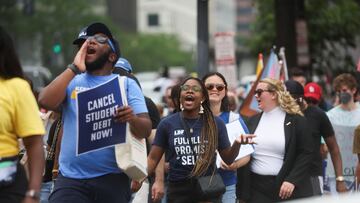Biden’s new student loan forgiveness plan: At what point is it and when could it begin to be applied?
The process for the Biden Administration’s second attempt at student loan relief has begun the next step. Here’s what we know so far about the process.

The sweeping federal student loan debt forgiveness announced by President Biden last year was thwarted by the Supreme Court this summer. Upon hearing the 6-3 decision ruling that the White House had overstepped its authority with the executive order the Biden administration set in motion a new attempt.
Whereas the first try at broad student debt relief was based on the 2003 HEROS Act, this latest will rest on the Higher Education Act. The latter gives the Education Secretary the authority to waive federal student loans, but “current regulations lack specificity on how that authority is applied,” said Under Secretary of Education James Kvaal.
For that reason a panel was put together by the Biden administration to perform a process known as negotiated rulemaking. The members will meet three times with the Department of Education over the coming months to clarify the rules on how the Education Secretary can cancel debt in the future.
You may be interested in: SAVE: How does Biden’s new student loan repayment plan work? How to sign up
Biden’s new student loan forgiveness plan: At what point is it and when could it begin to be applied?
Once the group of 14 negotiators, who the Biden administration picked from different interest groups in higher education, has given their input the administration will formulate the details of what Biden’s federal student loan debt relief program 2.0 will be. Then the panel will vote on the proposal.
If there is a consensus on a proposal, the agency will move forward with it. If there isn’t, then the department will propose its own plan. That will then have to go through a period of public comment, after which it can be finalized.
With negotiators meeting into December, it’s unlikely that the public will know who will be eligible for the new student loan forgiveness and how much until early next year at the soonest.
You may be interested in: Biden will forgive $9 billion in student debt for 125,000 Americans: These are the beneficiaries
Student loan borrowers should make payments in the meantime
The White House announced that student loan repayments and interest accrual, after being on pause for over three years, would begin at the end of summer. Specifically, interest began accruing on 1 September while payments resumed this month.
At the same time, Education Secretary Miguel Cardona announced that the agency was implementing a “12-month on-ramp transition period.” It is designed to protect borrowers who cannot make payments from “the harshest consequences of missed, partial or late payments.” The loans of borrowers who can’t pay their monthly bill in full during this period will not be referred to collection agencies nor go into default and it will not lead to negative credit reporting.
Federal Student Aid advises borrowers that if they can make payments, they should do so as even during this transition period interest will accrue. Borrowers are also advised to explore repayment plan options if they want to reduce their monthly payments such as the revamped income-driven repayment plan called Saving on a Valuable Education (SAVE) plan.






